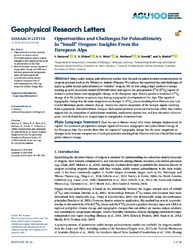Opportunities and Challenges for Paleoaltimetry in “Small” Orogens: Insights From the European Alps
DOI: https://doi.org/10.1029/2019GL086046
Persistent URL: http://resolver.sub.uni-goettingen.de/purl?gldocs-11858/8514
Persistent URL: http://resolver.sub.uni-goettingen.de/purl?gldocs-11858/8514
Botsyun, S.; Ehlers, T. A.; Mutz, S. G.; Methner, K.; Krsnik, E.; Mulch, A., 2020: Opportunities and Challenges for Paleoaltimetry in “Small” Orogens: Insights From the European Alps. In: Geophysical Research Letters, Band 47, 4, DOI: 10.1029/2019GL086046.
 |
Dokument öffnen: |
Many stable isotope paleoaltimetry studies have focused on paleoelevation reconstructions of orogenic plateaus such as the Tibetan or Andean Plateaus. We address the opportunities and challenges of applying stable isotope paleoaltimetry to “smaller” orogens. We do this using a high‐resolution isotope tracking general circulation model (ECHAM5‐wiso) and explore the precipitation δ18O (δ18Op) signal of Cenozoic paleoclimate and topographic change in the European Alps. Results predict a maximum δ18Op change of 4–5‰ (relative to present day) during topographic development of the Alps. This signal of topographic change has the same magnitude as changes in δ18Op values resulting from Pliocene and Last Glacial Maximum global climatic change. Despite the similar magnitude of the isotopic signals resulting from topographic and paleoclimate changes, their spatial patterns across central Europe differ. Our results suggest that an integration of paleoclimate modeling, multiproxy approaches, and low‐elevation reference proxy records distal from an orogen improve topographic reconstructions. Plain Language Summary:
Here we use a climate model with water isotopes implemented to explore the maximum precipitation isotopic signal of Cenozoic topographic and paleoclimate change in the European Alps. Our results show that the impact of topography change has the same magnitude as changes in the isotopic composition of local precipitation resulting from Pliocene and Last Glacial Maximum global climatic change. Key Points:
High‐resolution isotope tracking general circulation model (ECHAM5‐wiso) is used to explore changes in past oxygen isotope ratios in precipitation in the Alps.
Model‐simulated isotopic signals of topographic change and difference between glacials and interglacials show the same magnitude.
Low‐elevation proxy records improve reconstructions of paleotopography by reducing long‐term climate change bias.
Statistik:
ZugriffsstatistikSammlung:
- Geologie [930]
Schlagworte:
paleoaltimetrystable water isotopes
GCM
European Alps
paleoclimate
isotope tracking model
This is an open access article under the terms of the Creative Commons Attribution License, which permits use, distribution and reproduction in any medium, provided the original work is properly cited.

